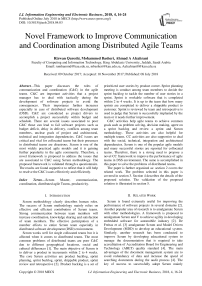Novel framework to improve communication and coordination among distributed agile teams
Автор: Rizwan Qureshi, Mohammed Basheri, Ahmad A. Alzahrani
Журнал: International Journal of Information Engineering and Electronic Business @ijieeb
Статья в выпуске: 4 vol.10, 2018 года.
Бесплатный доступ
This paper discusses the roles of communication and coordination (C&C) in the agile teams. C&C are important activities that a project manager has to deal with tactically during the development of software projects to avoid the consequences. Their importance further increases especially in case of distributed software development (DSD). C&C are considered as project drivers to accomplish a project successfully within budget and schedule. There are several issues associated to poor C&C those can lead to fail software projects such as budget deficit, delay in delivery, conflicts among team members, unclear goals of project and architectural, technical and integration dependencies. C&C issues are critical and vital for collocated teams but their presences in distributed teams are disastrous. Scrum is one of the most widely practiced agile models and it is gaining further popularity in the agile community. Therefore, a novel framework is proposed to address the issues that are associated to C&C using Scrum methodology. The proposed framework is validated through a questionnaire. The results are found supportive to reflect that it will help to resolve the C&C issues effectively and efficiently.
Scrum Master, communication, coordination, distributed agile Teams, productivity
Короткий адрес: https://sciup.org/15016139
IDR: 15016139 | DOI: 10.5815/ijieeb.2018.04.03
Текст научной статьи Novel framework to improve communication and coordination among distributed agile teams
Published Online July 2018 in MECS
Scrum methodology clearly describes human roles. The success of Scrum methodology mainly relies on effective and efficient contribution of Scrum teams. Strong communication between team members will increase coordination, knowledge sharing and satisfaction of team members. The effective participation of a member effects to entire Scrum team especially in distributed software development (DSD) environment.
The paper is further organized as: section 2 covers the related work. The problem selected in this paper is covered in section 3. Section 4 describes the details of the proposed solution. The validation of the proposed solution is illustrated in section 5.
-
II. Related Work
Scrum is found extremely useful for improving the performance of software projects in several domains [2]. Another popular area of research is to amalgamate Scrum with other methodologies. A framework is proposed to amalgamate Scrum and V to achieve agility in developing embedded software for automobile industry [2]. De Freitas et al. [3] amalgamate Scrum and Model Driven Development (MDD) to develop an educational system. Similarly, another research has been conducted to improve Scrum by developing educational system to manage the documentation that is required to take accreditation of Accreditation Board for Engineering and Technology (ABET) quality standard [4]. The main advantages of the document management system are to avoid redundancy of data and increase the speed of searching documents during the audit process [4]. The key of success to successfully adopt Scrum mainly depends on attitude and expertise of team members [5-6]. Many researchers are of the opinion that Scrum is a suitable methodology to teach educational courses. This is due to the fact that human factor is vital in order to successfully execute the management practices of Scrum. The use of Scrum in a course brings into several advantages such as high productivity, cohesiveness, communication and coordination [5-6]. Wangenheim et al. [6] use a simulation game to train Scrum in order to speed up the knowledge acquisition process. A model is also proposed to distinguish associations between Scrum and learning mechanism. The proposed model observes performance of the students following the Felder– Silverman model using a tool naming Virtual Scrum [5].
The success of team members to transform from traditional methodology to agile Scrum mainly relies on their attitudes [7]. A framework is proposed to increase the speed of delivery without compromising quality in the changing business environments. The Technology Acceptance Model (TAM) is used to propose the framework [7]. A hybrid fuzzy-ontological system is proposed to engineer a software process simulation modeling (SPSM) system [8]. SPSM simulates management processes and project roles of Scrum [8]. Sprint review and retrospective meetings are important activities of Scrum [9]. It is an important area of research to identify the best testing strategy using Scrum. A study is conducted to propose a model that is used to analyze the performance of regression test by developing mobile application using Scrum [9].
A novel solution is presented in the area of Agile Scrum to manage large teams [14]. Qurashi and Qureshi [14] report several limitations of Scrum using large teams such as repetition of work, poor communication, architectural and integration constraints. Scrum of Scrum methodology is proposed to address the main limitations of using large size teams. The main limitation of the study is that it is kept silent in the cases of more than one product owner and Scrum master [14]. Two case studies are reported to test the implementations of Scrum of Scrum on two large projects with distributed teams [15].
Scott et al. [5] report a survey indicating that many software development organizations face problems to manage the distributed agile teams. It is described that these problems can be managed by organizing workshops throughout the development of software. Scott et al. [5] emphasis that the software companies must consider the geographical distances and time zones while selecting the distributed teams and plan strategies to scale agile models for DSD projects.
Dorairaj and Noble [16] describe different means that can be used to improve trust and communication among DSD teams such as social media applications, collaboration, knowledge dissemination and culture of learning. It is also suggested to arrange training sessions to meet the strategic learning requirements of employees and organizations [16].
Scrum works extremely well for collocated teams due to its strong management practices but there are few studies available to check its performance in a distributed environment [17]. A case study is conducted using Scrum to develop DSD project to provide evidence. Three frameworks are applied to analyze data. It is concluded that Scrum also works well in a distributed environment because of its better management practices as compared to other agile models. It is also required to introduce state of the art project management computer aided software engineering (CASE) tools to plan; monitor and control distributed teams and improve communication and coordination among distributed teams.
Requirements are changed during the development of software projects due to variety of factors like on customer demands and business needs [18]. The project management is extremely tactical with distributed teams and changing requirements. This needs strong communication and coordination among distributed teams to accomplish the DSD projects successfully. It would help other researchers to identify the issues that the distributed teams could face in DSD projects [19]. A survey is reported to gather the issues that are encountered in DSD projects such as social, communication and coordination. It is recommended to use CASE tools to resolve social, communication and coordination issues in a DSD environment.
Scrum methodology needs to be customized to match the requirements of distributed projects [20]. Bass [20] classifies nine different roles of the product owner such as tutor, councilor, capable to prioritize user stories, expert and foresee risks. Bass (2010) generally emphasizes about the different roles of product owner in DSD projects. It is further required to investigate the functions of Scrum Master and Scrum team in DSD projects.
Jalali and Wohlin [21] report a survey to describe the strengths and consequences of practicing agile methodologies in DSD projects. It is also advised that how to tailor agile methodologies (and their practices) to increase their effectiveness as per the nature of software projects in a distributed environment. It is concluded that the success of agile methodologies mainly rely on their adoption as per the requirements and situations. The role of distributed teams is also promising while adopting agile methodologies to achieve success in DSD projects.
Estler et al. [22] examine sixty six (66) software projects to compare traditional and modern methodologies. The objective of study is in two folds. The first idea of the study is to set criteria that can be used to select an appropriate model as per the requirements. The second idea is to establish a relation between methodology and degree of achievement, value, inspiration and interaction. It is inferred that it does not matter that software companies select traditional (structured) or modern (agile) methodology to successfully develop DSD projects. Estler et al. [22] mention that there are other factors that affect to accomplish a successful DSD project such as selection of distributed team structure, communication, coordination, expertise of team members, attitude of team members, management support and domain knowledge.
Al-Zaidi and Qureshi [23] report the main communication issues that are encountered during DSD projects such as lack of cohesion, unclear goals, poor coordination and lack of knowledge sharing. A novel solution is proposed using Scrum practices to mitigate the communication risks of distributed teams. This is an attempt to address the communication issues of distributed teams but the study lacks in covering the coordination issues of distributed teams. The proposed solution needs to be further validated using case study to generalize the results.
The study is reported to highlight the usage of capability maturity model integration (CMMI) with the agile methodologies [24]. The agile methodologies are not compatible with the CMMI quality standards. Agile methodologies are proposed to develop small projects with minimum documentation. CMMI standard requires extensive documentation. A framework is proposed to merge the processes of agile Scrum methodology and CMMI and it will help the practitioners to adapt Scrum for the development of medium and large projects as per the processes of CMMI to develop high quality software. A survey is conducted to evaluate the proposed framework. The proposal requires implementation in a real software development project to check its effectiveness.
The enterprise resource planning (ERP) systems are getting popularity from last several years and several failure stories are also reported [25]. The study is conducted to identify critical failure and success factors. The quality of data and user involvement are two critical factors to fail an ERP system if they are not properly tackled. A data cleaning approach is proposed for the successful implementation of ERP systems. It is mentioned that an effective communication and coordination with the customer will help the development teams to avoid ambiguous requirements. The proposal of data cleaning is in the preliminary stage and it is presented without testing.
Qureshi and Sayid [26] present a scheme of global scrum management software for distributed teams. The main challenges of distributed teams are reported such as different geographical regions, time differences, poor coordination and communication and cultural issues. It is recommended to increase communication, rapid development and resource management for the successful implementation of DSD. A web based project management tool is proposed for the distributed teams to cope major challenges of DSD. The proposed tool is recommended to use with the Scrum methodology for the effective results.
-
III. Problem Statement
-
• How to improve the communication and coordination among distributed teams to successfully deploy Scrum?
-
IV. The Proposed Solution
The proposed solution is using Scrum methodology to address the research question. Scrum provides a strong management framework to deliver increments of software in the form of sprints. Scrum is an incremental methodology to deliver software as increments. The increments in Scrum are called as sprints. A novel Scrum methodology is proposed in this research as shown in fig.
-
1. The main phases of proposed Scrum methodology are Intialize, Develop, Run and Evaluate.
should organize daily meetings with the team to remove impediments.
The role of people is vital for the success of agile software development especially using Scrum methodology. It is a well-known methodology due to its strong management practices. Scrum development pays more attention to people due to several reasons like people help each other to identify problems, solve problems and take smart decisions to accomplish the project as per the expectations of stakeholders. This paper proposes a novel framework with an aim to help Scrum Master in achieving strong communication and coordination among distributed agile teams.
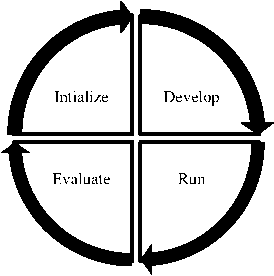
Fig.1. The Release Cycle of a Sprint
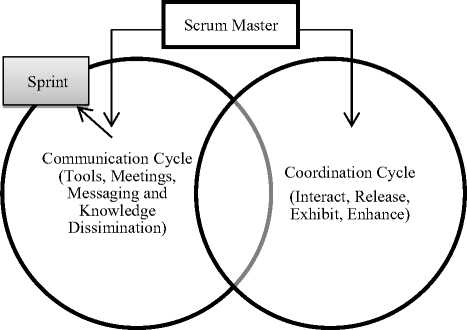
There are several telecommunication tools available to meet; share knowledge and message among distributed teams such as CISCO WebEx and TeamViewer. CISCO WebEx is introduced to arrange video conferencing. TeamViewer tool controls remote screens to provide technical support. The telecommunication tools will help the distributed teams to improve communication through online meetings, desktop sharing and group messaging.
Location A
Location B
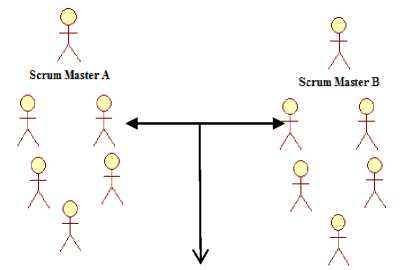
Location C
The DSD environment needs pipeline development. The pipeline development is hard in its nature to implement in a DSD project because of changing requirements, solutions and languages at each single location. The distributed teams are making decisions to solve the problems. These decisions have consequences affecting the DSD project such as conflicts, ambiguities and unclear goals. Therefore, it is vital to have strong interaction mechanisms to mitigate the risks of poor coordination to complete the DSD project within budget and schedule and as per the values of agile manifesto. Scrum methodology emphasizes that Scrum Master
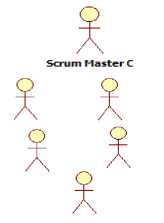
Fig.3. The Distributed Structure of Scrum Teams
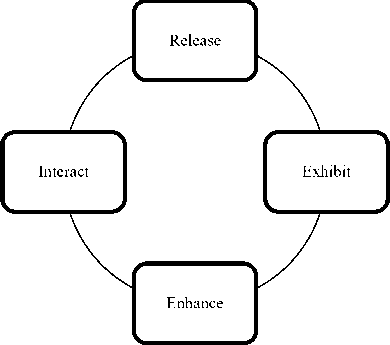
Fig.4. The Proposed Phases of Coordination Cycle
-
V. Validation
A questionnaire is used to validate the proposed framework and it is composed of twenty questions. Seven goals are designed to validate the proposed framework.
-
• Goal 1. Impact of online meeting tools on effective communication.
-
• Goal 2. Impact of remote desktop sharing on
effective communication.
-
• Goal 3. Impact of group messaging tools on
effective communication.
-
• Goal 4. Impact of ‘Interaction’ phase on effective coordination.
-
• Goal 5. Impact of ‘Release’ phase on effective
coordination.
-
• Goal 6. Impact of ‘Exhibit’ phase on effective
coordination.
-
• Goal 7. Impact of enhancement on ‘Interaction’
and ‘Release’ phases.
A descriptive analysis is performed to show the results using a frequency table and bar chart. The questions are evaluated using the likert scale i.e., 1 to 5.
-
A. Goal 1. Impact of online meeting tools on effective communication
Table 2 shows that 50% of the respondents report the strong impact of online meeting tools on effective communication in the DSD environment. It is also illustrated in Table 2 that 15.8% of the participants are suggesting very strong impact of online meeting tools on effective communication. 31.6% of the software professionals report the nominal impact. Only 2.6% of the software professionals respond the low impact of online meeting tools on effective communication.
-
B. Goal 2. Impact of remote desktop sharing on effective communication.
Table 3 shows that 50% of the respondents report the high impact of remote desktop sharing on effective communication in the DSD environment. It is also illustrated in Table 3 that 18.4% of the participants are suggesting very high impact of remote desktop sharing on effective communication. 21.1% of the software professionals report the nominal impact. and 7.9% of the participants report the low impact. Only 2.6% of the software professionals respond the very low impact of remote desktop sharing on effective communication.
-
C. Goal 3. Impact of group messaging tools on effective communication.
Table 4 shows that 57.9% of the respondents report the strong impact of group messaging tools on effective communication in the DSD environment. It is also illustrated in Table 4 that 34.2% of the participants are suggesting very strong impact of group messaging tools on effective communication. 5.3% of the software professionals report the nominal impact. Only 2.6% of the software professionals respond the low impact of group messaging tools on effective communication.
-
D. Goal 4. Impact of ‘Interaction’ phase on effective coordination.
Table 5 shows that 47.4% of the respondents report the high impact of interaction phase on effective coordination in the DSD environment. It is also illustrated in Table 5 that 23.7% of the participants are suggesting very high impact of interaction phase on effective coordination. 21.1% of the software professionals report the nominal impact. and 5.3% of the participants report the low impact. Only 2.6% of the software professionals respond the very low impact of interaction phase on effective coordination.
-
E. Goal 5. Impact of ‘Release’ phase on effective
coordination.
Table 6 shows that 50.0% of the respondents report the high impact of release phase on effective coordination in the DSD environment. It is also illustrated in Table 6 that 21.1% of the participants are suggesting very high impact of release phase on effective coordination. 21.1% of the software professionals report the nominal impact. Only 7.9% of the software professionals respond the very low impact of release phase on effective coordination.
Table 7 shows that 44.7% of the respondents report the high impact of exhibit phase on effective coordination in the DSD environment. It is also illustrated in Table 7 that 10.5% of the participants are suggesting very high impact of exhibit phase on effective coordination. 31.6% of the professionals report the nominal impact.
-
F. Goal 6. Impact of ‘Exhibit’ phase on effective
coordination.
Table 2. Cumulative Analysis of Goal 1
|
Likert Scale |
Frequency |
Percent |
Valid Percent |
Cumulative Percent |
|
Valid 1 |
1 |
2.6 |
2.6 |
2.6 |
|
3 |
12 |
31.6 |
31.6 |
34.2 |
|
4 |
19 |
50.0 |
50.0 |
84.2 |
|
5 |
6 |
15.8 |
15.8 |
100.0 |
|
Total |
38 |
100.0 |
100.0 |
Table 3. Cumulative Analysis of Goal 2
|
Likert Scale |
Frequency |
Percent |
Valid Percent |
Cumulativ Percent |
|
Valid 1 |
1 |
2.6 |
2.6 |
2.6 |
|
2 |
3 |
7.9 |
7.9 |
10.5 |
|
3 |
8 |
21.1 |
21.1 |
31.6 |
|
4 |
19 |
50.0 |
50.0 |
81.6 |
|
5 |
7 |
18.4 |
18.4 |
100.0 |
|
Total |
38 |
100.0 |
100.0 |
Table 4. Cumulative Analysis of Goal 3
|
Likert Scale |
Frequency |
Percent |
Valid Percent |
Cumulative Percent |
|
Valid 2 |
1 |
2.6 |
2.6 |
2.6 |
|
3 |
2 |
5.3 |
5.3 |
7.9 |
|
4 |
13 |
34.2 |
34.2 |
42.1 |
|
5 |
22 |
57.9 |
57.9 |
100.0 |
|
Total |
38 |
100.0 |
100.0 |
Table 5. Cumulative Analysis of Goal 4
|
Likert Scale |
Frequency |
Percent |
Valid Percent |
Cumulativ Percent |
|
Valid 1 |
1 |
2.6 |
2.6 |
2.6 |
|
2 |
2 |
5.3 |
5.3 |
7.9 |
|
3 |
8 |
21.1 |
21.1 |
28.9 |
|
4 |
18 |
47.4 |
47.4 |
76.3 |
|
5 |
9 |
23.7 |
23.7 |
100.0 |
|
Total |
38 |
100.0 |
100.0 |
Only 13.2% of the software professionals respond the very low impact of exhibit phase on effective coordination.
-
G. Goal 7. Impact of enhancement on ‘Interaction’ and ‘Release’ phases.
Table 8 shows that 26.3% of the respondents report the high impact of enhancement on interaction’ and release phases in the DSD environment. It is also illustrated in Table 8 that 34.2% of the participants are suggesting very high impact of enhancement on interaction’ and release phases. 31.6% of the software professionals report the nominal impact. Only 7.9% of the software professionals respond the very low impact of enhancement on interaction’ and release phases.
-
H. Final Cumulative analysis of goals 1 through 7 .
Table 10 shows the final cumulative analyses of goals 1 through 7.
According to Table 9, 69.2% of the respondents are agreed with the seven goals in which 24.8% of the software engineers are strongly agreed and 44.4% of the respondents are agreed. 23.3% of the participants are remained neutral for 7 goals. A total of 7.5% responses are disagreed with the seven goals, of which, 6.4% of the respondents are disagreed while 1.1% of the software engineers are strongly disagreed with the 7 Goals as shown in fig. 5.
-
I. Comparing Validation
Table 6. Cumulative Analysis of Goal 5
|
Likert Scale |
Frequency |
Percent |
Valid Percent |
Cumulative Percent |
|
Valid 2 |
3 |
7.9 |
7.9 |
7.9 |
|
3 |
8 |
21.1 |
21.1 |
28.9 |
|
4 |
19 |
50.0 |
50.0 |
78.9 |
|
5 |
8 |
21.1 |
21.1 |
100.0 |
|
Total |
38 |
100.0 |
100.0 |
Table 7. Cumulative Analysis of Goal 6
|
Likert Scale |
Frequency |
Percent |
Valid Percent |
Cumulative Percent |
|
Valid 2 |
5 |
13.2 |
13.2 |
13.2 |
|
3 |
12 |
31.6 |
31.6 |
44.7 |
|
4 |
17 |
44.7 |
44.7 |
89.5 |
|
5 |
4 |
10.5 |
10.5 |
100.0 |
|
Total |
38 |
100.0 |
100.0 |
Table 8. Cumulative Analysis of Goal 7
|
Likert Scale |
Frequency |
Percent |
Valid Percent |
Cumulative Percent |
|
Valid 2 |
3 |
7.9 |
7.9 |
7.9 |
|
3 |
12 |
31.6 |
31.6 |
39.5 |
|
4 |
13 |
34.2 |
34.2 |
73.7 |
|
5 |
10 |
26.3 |
26.3 |
100.0 |
|
Total |
38 |
100.0 |
100.0 |
Table 9. Final Cumulative analysis of goals 1 through 7
|
Goals |
Str. Disagree |
Disagree |
Neutral |
Agree |
Str. Agree |
|
Goal 1 |
2.6 |
0.0 |
31.6 |
50.0 |
15.8 |
|
Goal 2 |
2.6 |
7.9 |
21.1 |
50.0 |
18.4 |
|
Goal 3 |
0.0 |
2.6 |
5.3 |
34.2 |
57.9 |
|
Goal 4 |
2.6 |
5.3 |
21.1 |
47.4 |
23.7 |
|
Goal 5 |
0.0 |
7.9 |
21.1 |
50.0 |
21.1 |
|
Goal 6 |
0.0 |
13.2 |
31.6 |
34.2 |
26.3 |
|
Goal 7 |
0.0 |
7.9 |
31.6 |
34.2 |
26.3 |
|
Total |
7.8 |
44.8 |
163.4 |
311 |
173.7 |
|
Avg. |
1.1 |
6.4 |
23.3 |
44.4 |
24.8 |
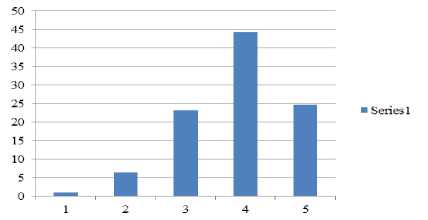
Fig.5. Final Cumulative Analysis of Seven Goals
-
VI. Conclusion
Table 10. Comparison of proposed work with the existing work
|
Proposed Approach |
Alyahya et al. [18] |
Paasivaara et al. [15] |
Al_Zaidi and Qureshi [23] |
Alqhtani and Qureshi [28] |
Asiri and Qureshi [29] |
|
|
Scrum Practices |
Yes |
Yes |
Yes |
Yes |
Yes |
Yes |
|
Novel Scrum Methodology |
Yes |
No |
No |
No |
No |
No |
|
Novel Communication Framework |
Yes |
No |
No |
Yes |
Yes |
Yes |
|
Coordination Framework |
Yes |
Yes |
No |
No |
No |
No |
|
Distributed Environment |
Yes |
Yes |
Yes |
Yes |
Yes |
Yes |
|
Tool Support |
Yes |
Yes |
No |
Yes |
Yes |
Yes |
|
Validation |
Yes |
No |
Yes |
Yes |
Yes |
Yes |
|
Extra Overhead Cost |
No |
Need to test |
No |
No |
No |
No |
|
Extra Effort |
No |
Need to test |
No |
No |
No |
No |
|
Extra Resources |
No |
Need to test |
No |
No |
No |
No |
|
Effective to reduce C&C issues |
Yes |
Need to test |
No |
No |
No |
No |
Список литературы Novel framework to improve communication and coordination among distributed agile teams
- Pressman R. S., Software Engineering, McGraw Hill Press, 2010.
- Cockburn A., Agile Software Development: The Cooperative Game, Addison-Wesley, 2007.
- de Freitas C. R., de Oliveira Junior J. A., Hino F. Y. A., Neto J. S., Vicente L. M., da Cunha A. M. and Dias L. A. V., “Applying Interdisciplinarity and Agile Methods in the Development of an Embedded System,” in proceedings of the 11th Int. Conf. Information Technology: New Generations, Las Vegas, USA, pp. 645-646, 2014.
- Mokhtar R., Jaafar N. H., Tahar N. F., Sukiman S. A., Aris A., and Abu Bakar N. F., “An integrated document management system for managing self programme accreditation using scrum approach,” in proceedings of Int. Symposium on Technology Management and Emerging Technologies (ISTMET), Bandung, Indonesia, pp. 102-106, 2014.
- Scott E., Rodríguez G., Soria Á., and Campo M., “Are learning styles useful indicators to discover how students use Scrum for the first time?,” Computers in Human Behavior, vol. 36, pp. 56-64, 2014.
- von Wangenheim C. G., Savi R., and Borgatto A. F., “SCRUMIA—An educational game for teaching SCRUM in computing courses,” Journal of Systems and Software, vol. 86, no. 10, pp.2675-2687, 2013.
- Overhage S., Schlauderer S., Birkmeier D., and Miller J., “What makes IT personnel adopt scrum? A framework of drivers and inhibitors to developer acceptance,” in proceedings of 44th Hawaii Int. Conf. System Sciences (HICSS), USA, pp. 1-10, 2011.
- Orłowskia C., Ziółkowskia, A., and Paciorkiewicz G., “Quantitative Assessment of the IT Agile Transformation,” Management and Production Engineering Review, vol. 8, no. 1, pp. 24-29, 2017.
- Parvez M., “A Managed Approach to Interact between Agile Scrum and Software Configuration Management System,” International Journal of System Computer, vol. 2, no. 2, pp. 87-91, 2012.
- Shrivastava S. V. and Rathod U., “Categorization of risk factors for distributed agile projects,” Information and Software Technology, vol. 58, pp. 373-387, 2014.
- Khalane T. and Tanner M., “Software quality assurance in Scrum: The need for concrete guidance on SQA strategies in meeting user expectations,” in proceedings of Int. Conf. Adaptive Science and Technology (ICAST), South Africa, pp. 1-6, 2013.
- Vlietland J., and van Vliet H., “Towards a governance framework for chains of Scrum teams,” Information and Software Technology, vol. 57, pp. 52-65, 2014.
- Heikkilä V. T., Paasivaara M., Rautiainen K., Lassenius C., Toivola T., and Järvinen J., “Operational release planning in large-scale scrum with multiple stakeholders—A longitudinal case study at F-Secure corporation,” Information and Software Technology, vol. 57, pp. 116-140, 2014.
- Qurashi S. A. and Qureshi M. R. J., “Scrum of scrums solution for large size teams using scrum methodology,” Life Science Journal, vol. 11, no. 8, pp. 443-449, 2014.
- Paasivaara M., Lassenius C., and Heikkila V. T., “Inter-team coordination in large-scale globally distributed scrum: Do Scrum-of-Scrums really work?,” in proceedings of Int. Conf. Empirical Software Engineering and Measurement (ESEM), Sweden, pp. 235-238, 2012.
- Dorairaj S. and Noble J., “Agile Software Development with Distributed Teams: Agility, Distribution and Trust,” in proceedings of Int. Conf. Agile Conference (AGILE), Australia, pp. 1-10, 2013.
- Pries-Heje L. P.-H. J., “Why Scrum Works: A Case Study from an Agile Distributed Project in Denmark and India,” in proceedings of Int. Conf. Agile Conference (AGILE), Salt Lake City, UT, pp. 20-28, 2011.
- Alyahya S., Ivins W., and Gray W., “Co-ordination Support for Managing Progress of Distributed Agile Projects,” in proceedings of Global Software Engineering Workshop (ICGSEW), Helsinki, pp. 31-34, 2011.
- Kamaruddin, N. K., Arshad N. H., and Mohamed A., “Chaos issues on communication in Agile Global Software Development,” in proceedings of Int. Conf. Business Engineering and Industrial Applications Colloquium (BEIAC), Kuala Lumpur, pp. 394-398, 2012.
- Bass J., “Agile Method Tailoring in Distributed Enterprises: Product Owner Teams,” in proceedings of Int. Conf. Global Software Engineering (ICGSE), Bari, pp. 154-163, 2013.
- Jalali S. and Wohlin C., “Agile Practices in Global Software Engineering - A Systematic Map,” in proceedings of Int. Conf. Global Software Engineering (ICGSE), Princeton, NJ, pp. 45-54, 2010.
- Estler H.-C., Nordio M., Furia C., Meyer B. and Schneider J., “Agile vs. Structured Distributed Software Development: A Case Study,” in proceedings of Int. Conf. Global Software Engineering (ICGSE), Porto Alegre, pp. 1197-1224, 2012.
- Al-Zaidi A., and Qureshi M. R. J., “Global Software Development Geographical Distance Communication Challenges,” International Arab Journal of Information Technology, vol. 14, no. 2, pp. 215-222, 2017.
- Hayat M, Qureshi M. R. J., “Measuring the Effect of CMMI Quality Standard on Agile Scrum Model,” International Journal of Information Engineering and Electronic Business (IJIEEB), vol.7, no.6, pp.46-52 , 2015.
- Qureshi M. R. J., Abdulkhalaq A. M., “Increasing ERP Implementation Success Ratio by Focusing on Data Quality & User Participation,” International Journal of Information Engineering and Electronic Business (IJIEEB), vol.7, no.3, pp.20-25, 2015.
- Qureshi M.R.J., and Sayid Isaac, “Scheme of Global Scrum Management Software,” International Journal of Information Engineering and Electronic Business (IJIEEB), vol. 7, no. 2, pp. 1-7, 2015.
- Ghosh G., “Challenges in Distributed Scrum,” in proceedings of Global Software Engineering (ICGSE), Porto Alegre, pp. 200, 2012.
- Alqhtani M. S. and Qureshi R. J., “A Proposal to Improve Communication between Distributed Development Teams,” International Journal of Intelligent Systems and Applications (IJISA), vol. 6, no. 12, pp. 34-39, 2014.
- Asiri S. and Qureshi R. J., “The Proposed GSD Model to Solve Coordination and Communication Problems,” International Journal of Modern Education and Computer Science (IJMECS), vol. 6, no. 11, pp. 25-30, 2014.

